Last updated: April 12, 2023
Article
Andersonville: Prisoner of War Camp (Teaching with Historic Places)
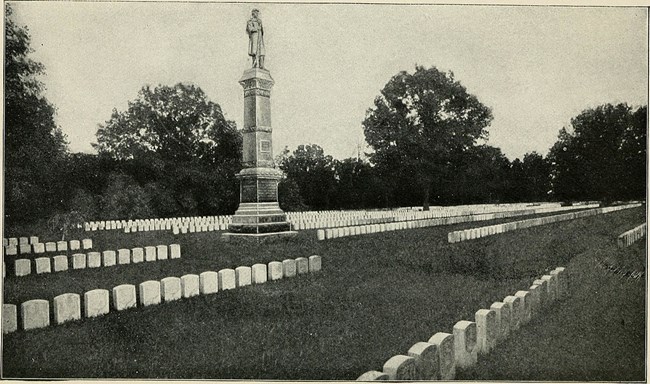
James Monroe Wells (1909), New York Public Library
This lesson is part of the National Park Service’s Teaching with Historic Places (TwHP) program.
John McElroy wrote in 1864 of the beginning of his stay at the Confederacy's largest prison camp, Andersonville Prison, or Camp Sumter as it was officially known, in southwest Georgia:
Five hundred men moved silently toward the gates that would shut out life and hope for most of them forever. Quarter of a mile from the railroad we came into a massive palisade with great squared logs standing upright in the ground. Fires blazed up and showed us a section of these and two massive wooden gates with heavy iron hinges and bolts. They swung open as we stood there and we passed through into the space beyond. We were at Andersonville.¹
Approximately 45,000 prisoners would enter Andersonville's gates during its 14- month existence. Nearly 13,000 would never see freedom again.
¹John McElroy, This Was Andersonville, Ray Meredith, ed. (New York: Fairfax Press, 1979), 5
About This Lesson
This lesson is based on the National Register of Historic Places registration file, "Andersonville National Historic Site" (with photographs), park documents, and publications. This lesson was written by Alan Marsh, former supervisory Park Ranger at Andersonville National Historic Site. It was edited by Teaching with Historic Places staff. This lesson is one in a series that brings the important stories of historic places into classrooms across the country.
Where it fits into the curriculum
Time Period: Late 19th century
Topics: The lesson could be used in units on the Civil War or on prisoners of war.
United States History Standards for Grades 5-12
Andersonville: Prisoner of War Camp relates to the following National Standards for History:
Era 5: Civil War and Reconstruction (1850-1877)
- Standard 2A: The student understands how the resources of the Union and Confederacy affected the course of the war.
- Standard 2B: The student understands the social experience of the war on the battlefield and homefront.
Curriculum Standards for Social Studies
National Council for the Social Studies
Andersonville: Prisoner of War Camp relates to the following Social Studies Standards:
Theme II: Time, Continuity and Change
- Standard D: The student identifies and uses processes important to reconstructing and reinterpreting the past, such as using a variety of sources, providing, validating, and weighing evidence for claims, checking credibility of sources, and searching for causality.
Theme III: People, Places, and Environment
-
Standard B: The student creates, interprets, uses, and distinguishes various representations of the earth, such as maps, globes, and photographs.
- Standard I: The student describes ways that historical events have influenced, physical and human geographic factors in local, regional, national and global settings
Theme V: Individuals, Groups, and Institutions
-
Standard E: The student identifies and describes examples of tensions between belief systems and government policies and laws.
Theme VI: Power, Authority, and Governance
-
Standard C: The student analyzes and explains ideas and governmental mechanisms to meet needs and wants of citizens, regulate territory, manage conflict, and establish order and security.
- Standard G: The student describes and analyzes the role of technology in communications, transportation, information-processing, weapons development, or other areas as it contributes to or helps resolve conflicts.
Theme VII: Production, Distribution, and Consumption
-
Standard B: The student describes the role that supply and demand, prices, incentives, and profits play in determining what is produced and distributed in a competitive market system.
Theme IX: Global Connections
-
Standard D: The student explores the causes, consequences, and possible solutions to persistent, contemporary, and emerging global issues, such as health, security, resource allocation, economic development, and environmental quality.
- Standard F: The student demonstrates understanding of concerns, standards, issues, and conflicts related to universal human rights.
Theme X: Civic Ideals, and Practices
- Standard C: The student locates, accesses, analyzes, organizes, and applies information about selected public issues - recognizing and explaining multiple points of view.
- Standard D: The student practices forms of civic discussion and participation consistent with the ideals of citizens in a democratic republic.
Objectives for students
1. To describe living conditions in a Civil War prison camp and the causes of these conditions;
2. To discuss methods used by prisoners to cope with the prison environment and conditions;
3. To explain how value systems influence attitudes and behavior of prisoners of war;
4. To examine Andersonville's emotional impact on the nation during the post-war months;
5. To identify the location of prisoner of war camps in their community or region.
Materials for students
The materials listed below can either be used directly on the computer or can be printed out, photocopied, and distributed to students.
1. Two maps of Civil War prison camps, and Andersonville, Georgia;
2. Two readings on Andersonville Prison and life as a prisoner of war;
3. Two drawings of the site and a picture drawn from the memory of an Andersonville prisoner;
4. Two historic photographs of Andersonville Prison
Visiting the site
Andersonville National Historic Site is located 10 miles northeast of Americus on Georgia Highway 49. The 482-acre park consists of the site of Andersonville Prison and a national cemetery. A visitor center and museum contain information on Civil War prisons and the overall prisoner of war story. The grounds are open daily from 8 a.m. until 5 p.m. The visitor center and museum are closed New Year's Day and Christmas Day. For more information, write to Andersonville National Historic Site, Route 1, Box 800, Andersonville, GA 31711, or visit the park's web pages.
Getting Started
Inquiry Question
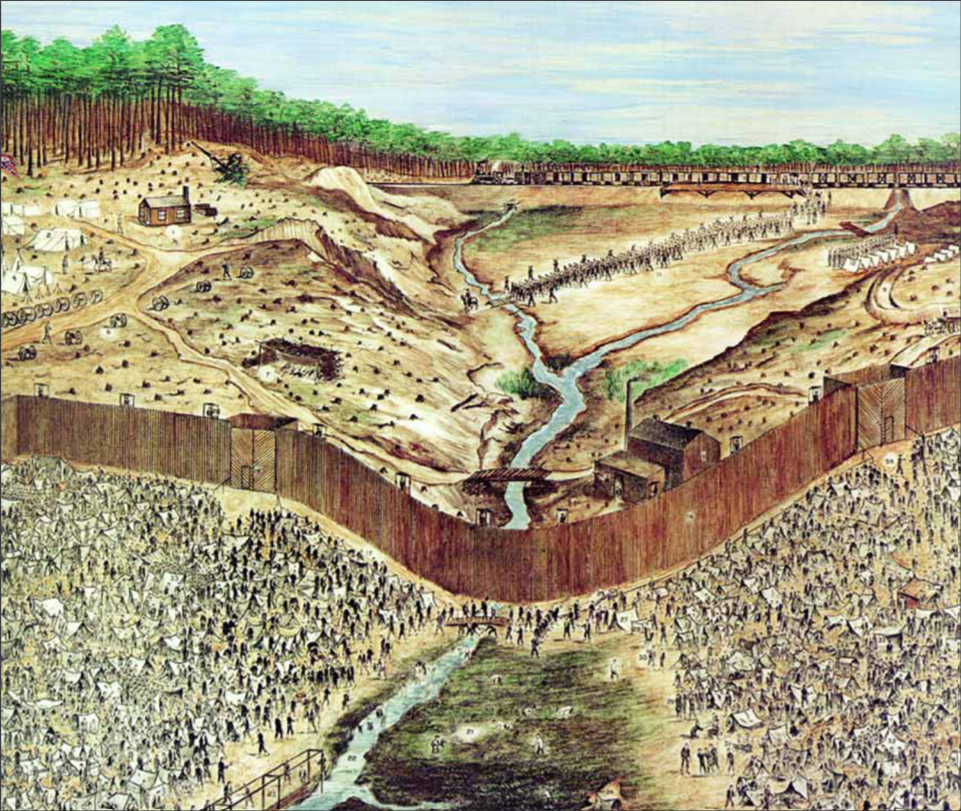
Thomas O'Dea (1885)
What might this place be?
Setting the Stage
When the Southern states first considered secession, most people believed that if war came, it would be brief. They did not envision four years of fighting that would lead to cruel deaths and the thousands that were captured as prisoners of war. In 1862 a system of parole and exchange was informally adopted by the Union and Confederate governments. A "paroled" prisoner pledged not to participate in the war or assist his allies. He would often be released on the spot to proceed to a camp where paroled soldiers were concentrated until the two governments officially exchanged prisoners. He could then return to the military. In the fall of 1863, the U.S. government suspended exchanges. The growing number of captured soldiers soon began filling Union and Confederate prisons.
Although conditions were bad in both Southern and Northern prison camps, the large number of prisoner deaths at Georgia's Andersonville Prison combined with the defeat of the Confederate states resulted in national attention and public outrage on the treatment of Union prisoners there.
Locating the Site
Map 1: Civil War prison camps
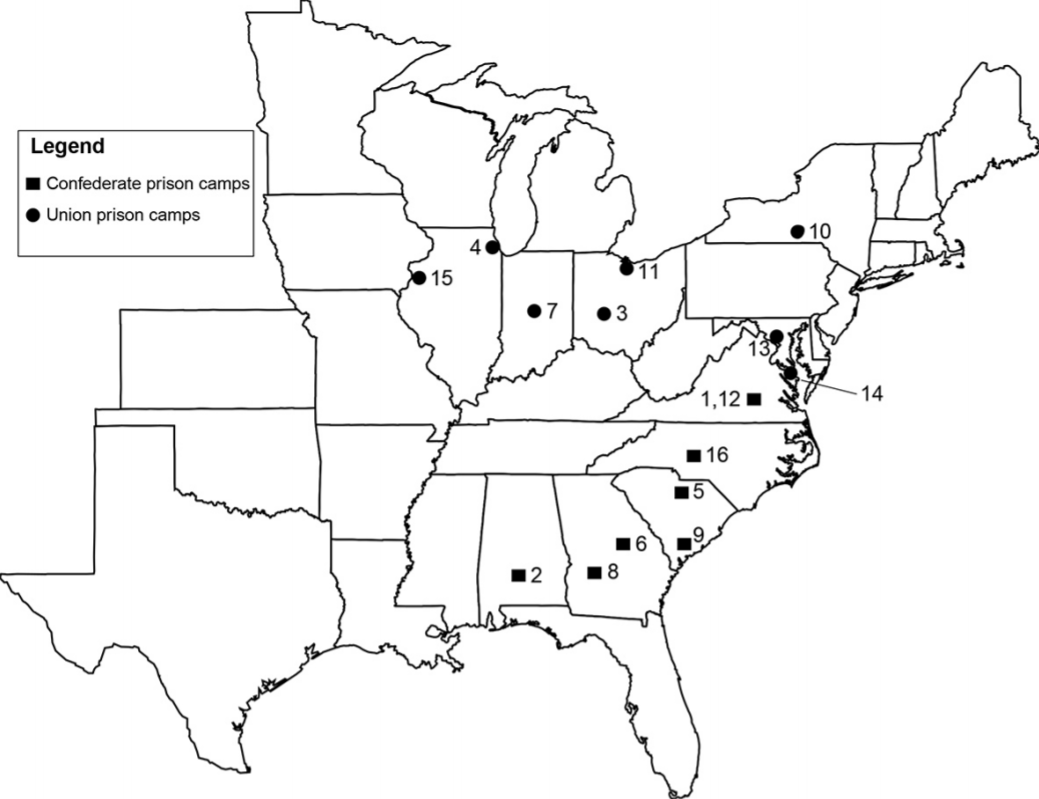
Andersonville National Historic Site, National Park Service
Union and Confederate Civil War prison camps:
1. Bell Isle—Richmond, Virginia
2. Cahaba Prison—Cahaba, Alabama
3. Camp Chase—Columbus, Ohio
4. Camp Douglas—Chicago, Illinois
5. Camp Florence—Florence, South Carolina
6. Camp Lawton—Millen, Georgia
7. Camp Morton—Indianapolis, Indiana
8. Camp Sumter—Andersonville, Georgia
9. Castle Pickney—Charleston, S.C.
10. Elmira Prison—Elmira, New York
11. Johnson's Island—Sandusky, Ohio
12. Libby Prison—Richmond, Virginia
13. Old Capitol Prison—Washington, D.C.
14. Point Lookout—Point Lookout, MD
15. Rock Island—Rock Island, Illinois
16. Salisbury—Salisbury, North Carolina
Questions for Map 1
1) List the states with prison camps. Which of these states were Union and which were Confederate?
2) Find Andersonville Prison and describe its location in terms of the other Confederate prison camps.
3) What factors do you think may have influenced the placement of Civil war prison camps?
Locating the Site
Map 2: Location of Andersonville, Georgia

Andersonville National Historic Site, National Park Service
Questions for Map 2
1) Based on Map 2, what additional reasons can you think of for choosing prison camp locations, specifically Andersonville?
Determining the Facts
Reading1: Andersonville Prison
Andersonville, or Camp Sumter as it was officially known, was the largest of several military prisons established during the Civil War. It was built in 1864 after Confederate leaders decided to move the many Union prisoners in Richmond, Virginia to a location away from the war. A site was needed where the prisoners could be guarded by fewer men, there would be less chance of military raids to free them, and food would be more abundant. The town of Andersonville was located on a railroad line approximately 65 miles southwest of Macon, Georgia. The village, near a small stream and in a remote agricultural area, seemed ideal. Construction of the 16 1/2 acre prison camp began in January 1864. Pine logs, 20 feet in length, were placed five feet deep in the ground to create a wooden stockade. In June 1864, the prison was enlarged to 26 1/2 acres. The prison proper was in the shape of a rectangle 1,620 feet long and 779 feet wide. Sentry boxes, or "pigeon roosts," were placed at 30 yard intervals along the top of the stockade. Along the interior of the stockade, 19 feet from the stockade wall, was a line of small wooden posts with a wood rail on top. This was the "deadline." Any prisoner who crossed the deadline could be shot by guards stationed in the sentry boxes. Small earthen forts around the exterior of the prison were equipped with artillery to put down disturbances within the compound and to defend against Union cavalry attacks.
The first prisoners arrived on February 25, 1864, while the stockade wall was still under construction. Small earthworks, equipped with artillery, overlooked the compound. Designed to hold 10,000 prisoners, the prison was soon overcrowded, holding 22,000 by June. Although the prison was enlarged, the number of prisoners continued to swell. By August 1864, more than 32,000 prisoners were confined at Andersonville.
Hindered by deteriorating economic conditions, an inadequate transportation system, and the need to concentrate all available resources on its own army, the Confederate government was unable to provide adequate housing, food, clothing, shelter, and medical care for its captives. These conditions, along with a breakdown of the prisoner exchange system, created much suffering and a high mortality rate. More than 45,000 Union soldiers were sent to Andersonville during the 14 months of the prison's existence. Of these, 12,912 died from disease, malnutrition, overcrowding, or exposure. They were buried in shallow trenches, shoulder to shoulder, in a crude cemetery near the prison.
In September 1864, when General William T. Sherman's forces occupied Atlanta, and a Union cavalry column threatened Andersonville's security, most of the prisoners were moved to other camps in Georgia and South Carolina. The prison operated on a much smaller scale for the remaining six months of the war.
Following the Confederate surrender in April 1865, Clara Barton, later founder of the American Red Cross, and Dorence Atwater, a former prisoner assigned as a parolee to keep burial records for prison officials, visited the cemetery at Andersonville to identify and mark the graves of the Union dead. During the war Atwater had labeled the soldiers by name and number after their deaths. Through Barton and Atwater's efforts, the cemetery was dedicated as Andersonville National Cemetery in August 1865.
Another important event that occurred after the war was the arrest and trial of Captain Henry Wirz, the commandant of the prison. Wirz was arrested and charged with conspiring to "impair and injure the health and destroy the lives of federal prisoners" and with "murder in violation of the laws of war." At his trial in Washington D.C., many former prisoners testified against him, vividly describing conditions at the prison. The former prisoners (and one who testified but was never actually a prisoner) blamed Wirz as the cause of their suffering. Historical documents, however, attest to the fact that prison officials attempted to acquire supplies for the prisoners but were severely hampered by the need to use supplies for the military and war effort. The question of whether or not Wirz could have done more to make life more bearable for the prisoners is still debated today. Was he simply a convenient scapegoat? Because of public outrage and indignation in the North over conditions at Andersonville, Captain Henry Wirz was found guilty of war crimes and was hanged on November 10, 1865. It has been said that Wirz was the last casualty of Andersonville.
Reading 1 was compiled from J. Mark Bollinger and Brenda Landrum, eds., Andersonville National Historic Site (Eastern National Park and Monument Association, 1987); Ovid Futch, History of Andersonville Prison (Gainesville: University of Florida Press, 1968); John McElroy, This Was Andersonville, Roy Meredith, ed. (New York: Fairfax Press, 1979); John Ransom, John Ransom's Andersonville Diary (New York: Berkley Publishing Group, 1986); and the visitor's guide for Andersonville National Historic Site.
Questions for Reading 1
1) Why was Andersonville chosen as the site for a prison camp? Check to see if the reasons are similar to those raised in Locating the Site. Discuss any new ideas presented.
2) Why did the prison have such a high mortality rate?
3) Who was responsible for the conditions and deaths at Andersonville?
4) After the war, prisoners held at Andersonville returned with horrible stories of prison life. What post-war events were directly influenced by former prisoners?
5) "Wirz was the last casualty of Andersonville." Do you think this is true? Explain your reasons. Was justice carried out? Discuss.
Determining the Facts
Reading 2: Life as a Prisoner
Soldiers and civilian support personnel from 26 states and the District of Columbia were imprisoned at Andersonville. Among the diverse prison population at Andersonville were American Indians, African Americans, men from several foreign countries, and two women. All prisoners found themselves confronting common obstacles and problems at Andersonville, including the need for shelter, clothing, food, water, and medical attention. Prisoners tried in various ways to make the most of a terrible situation.
Prisoners arriving at Andersonville quickly discovered that they lacked many of life's basic necessities. Many were without shelter and constructed crude dwellings known as "shebangs," made from various items including cloth, mud bricks, tree limbs, and brush. One group of prisoners, including a printer from Trenton, New Jersey, constructed a shebang by sewing together "the sleeve and back linings of my blouse...our sugar and coffee bags, and... the flap of Hoffman's knapsack."¹ In some instances, prisoners shared their shebangs with others and cared for those who were sick.
Clothing also presented a problem at the prison and prisoners spent much time mending their torn clothes. Some prisoners did not even have clothes. When a prisoner died and was carried out of the stockade to the "deadhouse" before burial, he would be stripped and his clothes were taken back inside the prison. (On one such occasion, the deceased prisoner was discovered to be a woman). Besides being torn and tattered, the clothing was consistently dirty, as soap was hard to come by and often not available at all. Prisoners sometimes used sand as a soap substitute. Twenty-one-year-old Albert Shatzel, a private in Company A, First Vermont Cavalry, recorded during his first day at Andersonville that "since the day I was Born I never saw such misery as there is here...they can't get aney soap or aney thing else to wash their clothes with."² Another prisoner, John Ransom, made the most of his situation by operating a barber shop and a laundry service. He also used sand for soap.
Perhaps the worst condition prisoners faced was the lack of food and water. The standard daily food ration was one-quarter pound of cornmeal and either one-third pound of bacon or one pound of beef. Sometimes other items would be issued such as peas or molasses. Often the rations were issued uncooked and prisoners had to cook for themselves. That was not an easy task since firewood was scarce. Prisoners often combined their rations and cooked them together. If a prisoner had money he could do business with the sutler, who operated a small store within the stockade and sold vegetables and other food. In May 1864 eggs sold for 50 cents each, molasses 12 dollars a gallon, bacon 6 dollars a pound, cornbread 40 cents a loaf, and flour one dollar a pint. Black beans were 40 cents a pint. In June baking soda was 25 cents a spoonful, blackberries 60 cents a pint, and beans had risen to one dollar a pint.
One reason Camp Sumter was built at Andersonville was the availability of water. A small stream, called Stockade Branch, flowed through the stockade. This water source, however, flowed through two Confederate encampments and the prison bakehouse before reaching the prisoners. Once it reached the stockade it was the only water supply for drinking, washing clothes, and bathing. The prison latrines, or "sinks," were built on the hillside above the branch and overflowed after heavy rains, sending the contents into the water supply and coating the ground after the water subsided. Among several diary entries by prisoners, John Ransom's account is less graphic than some, but straight to the point. Ransom wrote "There is so much filth about the camp that it is terrible trying to live here."³ When a spring flowed out of the ground after a heavy August rainstorm and created a new water supply, the prisoners, attributing it to an act of Providence, named it Providence Spring.
It is no surprise that under these circumstances sickness was rampant in Andersonville Prison. A hospital originally located within the stockade was later moved outside. Some tents were used, and eventually wooden buildings built, but they were not enough to accommodate the large number of sick. From February 25 to May 9, 1864, 4,588 patients received treatment and 1,026 died.4 The leading causes of death as reported by the medical staff were diarrhea, dysentery, and scorbutus (scurvy).
Inside the prison, a group of prisoners called the "Raiders" banded together to improve their situation by preying on fellow prisoners. Operating in large groups, the Raiders stole food and property by force. Armed with clubs and other items, the Raiders sometimes killed to obtain money jewelry, clothes, and food. For several months during the spring and early summer of 1864, the Raiders literally ruled the inner stockade at Andersonville. Finally in late June and early July of 1864, a group of prisoners banded together to oppose the Raiders. The "Regulators," with the permission of Captain Wirz, rounded up the Raiders. Once captured, many were forced to run between two lines of fellow prisoners who beat them as they ran. Others had to wear a ball and chain or were put in the stocks. Six leaders of the Raiders suffered a worse fate. These men were tried by a jury of 12 fellow prisoners and found guilty of murder. They were sentenced to hang, and the sentence was carried out on July 11, 1864.
To cope with the horrible conditions within the stockade, prisoners turned to various activities. They carved objects, sang songs, played games such as checkers and cards, read any material they could get, and wrote letters and diaries. Letters home were censored by prison officials, and many never reached their destinations. Other prisoners, intent on escape, spent time digging tunnels. Although there are no records of successful escapes via tunnels, some men did escape, mainly from work crews when outside the prison. The escape of one ingenious soldier was recorded by John Ransom on May 16, 1864. "A funny way of escape has just been discovered by Wirz. A man pretends to be dead and is carried on a stretcher, left with the row of the dead. As soon as it gets dark Mr. Deadman jumps up and runs."5
The horrendous living conditions at Andersonville resulted in the deaths of thousands of prisoners. John Ransom, who was imprisoned at Andersonville for seven months, attributed his ability to survive to "an iron constitution that has carried me through, and above all a disposition to make the best of everything no matter how bad, and considerable willpower with the rest."6
Reading 2 was compiled from J. Mark Bollinger and Brenda G. Landrum, eds., The Story of Andersonville Prison and American Prisoners of War (Eastern National Park and Monument Association, 1987); Donald F Danker, ed. "Imprisoned at Andersonville: The Diary of Albert Harry Shatzel, May 5, 1864 - September 12, 1864," Nebraska History, XXXVIII (1958); Ovid Futch, History of Andersonville Prison (Gainesville: University of Florida Press, 1968); John McElroy, This Was Andersonville, Roy Meredith, ed. (New York: Fairfax Press, 1979); and John Ransom, John Ransom's Andersonville Diary (New York: Berkley Publishing Group, 1986).
1 Ovid Futch, History of Andersonville Prison (Gainsville: University of Florida Press, 1968), 31.
2 Donald F. Danker, "Imprisoned at Andersonville: The Diary of Harry Shatzel, May 5, 1864- September 12, 1864," Nebraska History, XXXVIII (1958), 92.
3 Ransom, 66.
4 Futch, 33.
5 Ransom, 79.
6 Ransom, 159.
Questions for Reading 2
1) Define the terms shebang, deadhouse, and sutler.
2) What were some necessities the prisoners lacked? Why weren't these items available?
3) If prisoners had the money, what could they buy in the prison?
4) What were the leading causes of death? Why?
5) Who were the Raiders? Why do you think they behaved in such a manner? What was their ultimate fate?
6) What did the prisoners do to keep themselves occupied and entertained?
7) What means of escape were attempted by prisoners?
Visual Evidence
Drawing 1: Andersonville Prison site

Andersonville National Historic Site, National Park Service
Much of the stockade and prison buildings at Andersonville had either rotted or been hauled off for firewood within several years of the Civil War's end. Today, the northeast corner, the southeast corner, and the north gate have been reconstructed to give visitors a better idea of what the prison looked like during its operation. Several monuments, erected in the early 20th century, honor troops from different states who were imprisoned at Andersonville. Since 1971 the prison site and the nearby national cemetery have been administered by the National Park Service as Andersonville National Historic Site.
Questions for Drawing 1
1) Using Readings 1 and 2 as references, define as many of the elements labeled on the map as you can.
2) Do you think it is important to preserve the site of Andersonville prison even though the prison itself no longer exists? Why or why not?
Visual Evidence
Drawing 2: Andersonville Prison as it appeared in August 1864.

Thomas O'Dea (1885)
O'Dea was a prisoner at Andersonville. He said the following:
A Picture Worth a Thousand Words
I never drew a picture before in my life. Were I an artist, I could have completed it in a short time. I commenced this work in the winter of 1879 and finished it in 1885 devoting to it my leisure moments for over 5 years....
...In executing the work, I had no picture, map, plan or scale to guide or instruct me, but I relied upon and drew the whole subject from memory. To the casual observer, such a thing may be looked upon as absurd and impossible, that it is impossible after such a length of time for "memory" to retain such a perfect list and one of details as here portrayed and that I must have had assistance from some other source to be able to present such a vast combination of characters and situations in so perfect manner. Ah my friends, had you been there and experienced the sufferings that, in common with the thousands of other unfortunates who "were there," you too, like myself, would have the whole panorama photographed in your memory to remain there to your dying day...
- Thomas O'Dea, 1887
Questions for Drawing 2
1) Based on the portion of O'Dea's drawing shown above, how would you describe the prison and its surrounding area?
2) Do the artist's words help you understand the impact Andersonville prison had on its occupants? If so, how?
3) Why might he have drawn this image? Why did it take him so long to complete?
4) Find the prisoners who are on their way to the stockade from the railroad. How might prisoners in this situation have felt? How do you think they might have felt after they entered the prison?
Visual Evidence
Photo 1: Andersonville Prison (looking southeast from the sinks), 1864
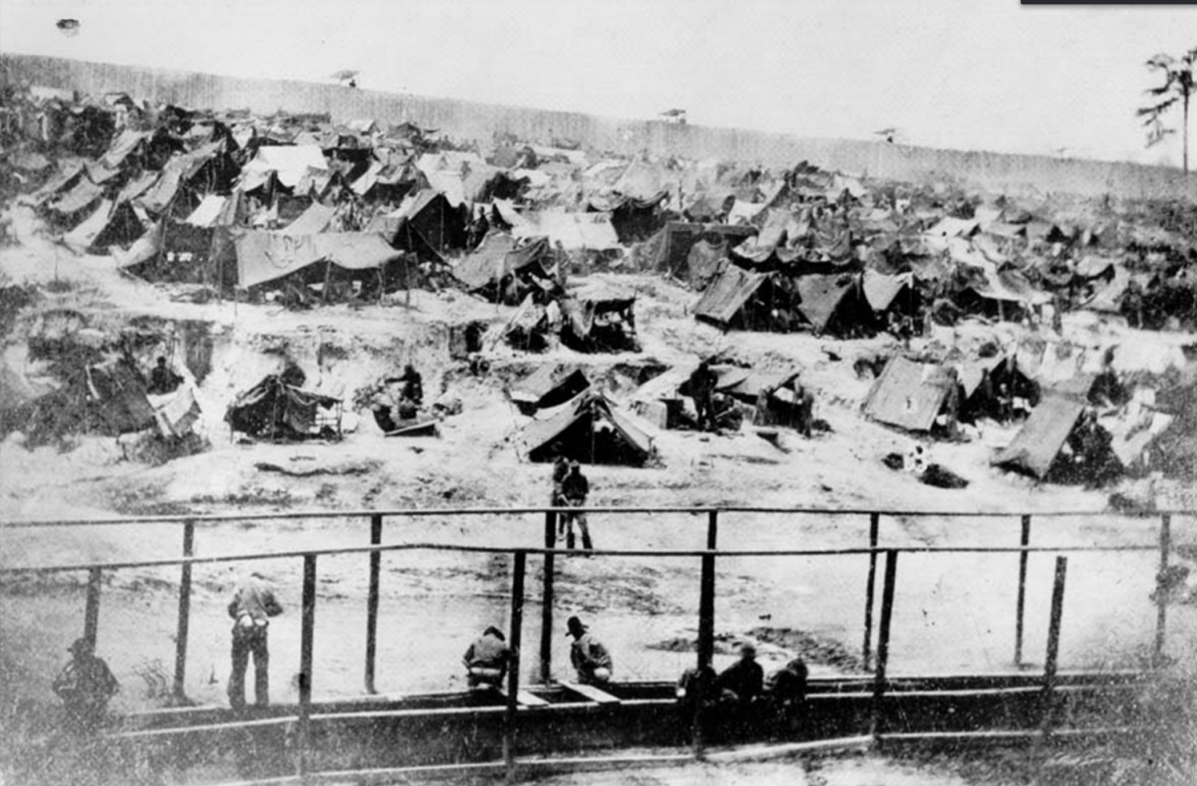
Andersonville National Historic Site, National Park Service
Photo 2: Andersonville Prison, 1864
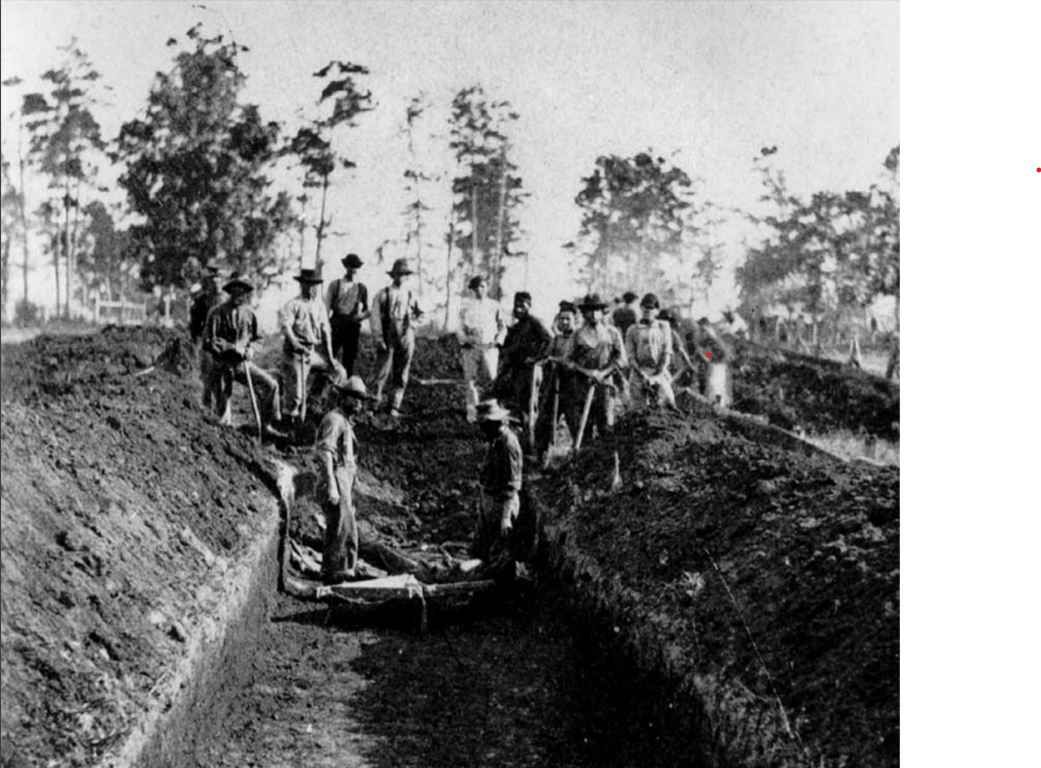
Andersonville National Historic Site, National Park Service
Questions for Photos 1 & 2
1) Locate the shebangs, sinks, and stockade walls in Photo 1. Can you find the tops of any pigeon roosts rising above the walls?
2) What are the prisoners doing in Photo 2? Why would Dorence Atwater's work of labeling each body before burial have been important?
Putting It All Together
Andersonville Prison was shut down when the war ended in 1865. Some former prisoners remained in federal service, but most returned to their prewar civilian occupations. Andersonville Prison would not be forgotten, either by those who experienced it or by later generations of Americans. It continues to symbolize the prisoner of war experience: physical and mental suffering and the need to cope with almost intolerable conditions. The following activities will provide students with an opportunity to better comprehend the prisoner of war experience and understand how the story of Andersonville is relevant today.
Activity 1: Individual Histories
Have students research firsthand accounts from an individual who fought or lived during the Civil War. (Most libraries have several volumes of such accounts and there also are many resources online). Ask all students to write an essay describing what those persons did during the war and how the war affected their lives.
Activity 2: Money in Prison
Ask students to review Reading 2 and record all references to money. Remind them that prisoners did not receive any rations. If they were to eat, they had to buy their food. What were different ways that prisoners chose to spend their money? If prisoners had to spend their money on food, why would they pay to have their hair cut or laundry washed?
Activity 3: Prisoner of War Camps
Ask the students to research the existence of prisoner of war camps (from any war) in their local area, their state, or a nearby state. The state historical library can provide research materials if a camp was located in the state or in a nearby state. Where were the prisoners from? Compare this prison with Andersonville.
Activity 4: Interview a Former Prisoner of War
As a class, develop an outline for an interview or discussion questions to ask a former prisoner of war (POW). Students may arrange interviews on their own, or you may ask a former POW to speak to your class. (Organizations such as the American Legion and Veterans of Foreign Wars are excellent sources for locating former prisoners of war who are willing to visit schools). On the following day, have students compare their guest's experience with that of the prisoners at Andersonville.
Additional Resources
Andersonville National Historic Site
Andersonville National Historic Site is a unit of the National Park System. The park's web page details the history of the park and visitation information.
National Park Service Civil War Website
Visit the official National Park Service Civil War website. Offering the current generation of Americans an opportunity to know, discuss, and commemorate this country's greatest national crisis, while at the same time exploring its enduring relevance in the present, the website includes a variety of helpful features and links such as the About the Civil War page that offers a timeline and stories from various perspectives. Also included are links to Civil War Parks, NPS education programs, and much more.
Civil War Soldiers & Sailors System
The National Park Service's Civil War Soldiers & Sailors System is a recently created database containing facts about Civil War servicemen, lists of Civil War regiments, and descriptions of significant Civil War battles. Also on this site is a descriptive history of African-Americans in the Civil War.
Southeast Archeological Center
The Southeast Archeological Center, a division of the National Park Service, has information about archeological investigations at Andersonville Civil War Prison.
National Archives and Records Administration
The National Archives and Records Administration offers a wealth of information about the Civil War as well as Andersonville Prison. Included on the site when searching "Andersonville Prison" is a special collection of photographs covering many aspects of the Civil War, such as prisoners and prisons. Another interesting search on "Civil War records" provides comprehensive sources of Union and Confederate records.
Library of Congress
The Library of Congress web page has selected Civil War photographs in their digital collections.
The Valley of the Shadow
For a valuable resource on the Civil War, visit the University of Virginia's Valley of the Shadow Project. The site offers a unique perspective of two communities, one Northern and one Southern, and their experiences during the American Civil War. Students can explore primary sources such as newspapers, letters, diaries, photographs, maps, military records, and much more.
Wirz Trial Home Page
The Wirz Trial Home Page provides coverage of the famous trials surrounding the execution of Henry Wirz. Included on the site is a discussion about the controversies of the trial, the impact it had on military rules of conduct, and the legal implications. The materials were prepared as part of a class assignment at the University of Missouri-K.C. School of Law.
Tags
- teaching with historic places
- twhp
- georgia
- georgia history
- military wartime history
- mid 19th century
- andersonville
- military history
- civil war
- prisoner of war
- prisons
- union soldiers
- civil war prison
- civil war prisoner of war camps
- archaeological site
- archaeology
- archeological survey
- archeology
- archeological artifacts
- archeological site
- prison
- prisoner-of-war camps
- cemetery
- civil war cemeteries
- twhplp
